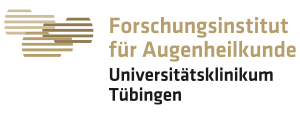Trauzettel-Klosinski Lab
Vision Rehabilitation Research Unit
Home » Labs » Clinical Research Labs » Trauzettel-Klosinski Lab » Research Topics
Research Topics
1) Analysis and rehabilitation of reading disorders in patients with visual field defects
1.1. Reading disorder in patients with maculopathy
Patients with maculopathy (age-related and iuvenile) have a reduced visual acuity and a central scotoma, which cause reading impairment.
AMD is the most common cause for severe visual impairment in the Western world. The prevalence is 2-4 million patients in Germany and approximately 150 million patients worldwide. The main impairment is reading disability.
Spontaneous adaptive mechanisms such as eccentric fixation and magnifying the text can restore reading ability. The analysis of the pathology and the adaptive mechanisms are the basis for specific rehabilitative measures, which we develop and evaluate in our lab.
The aim is to improve reading performance by optimal reading material, visual aids and specific training. The aim is further to apply the results of the scientific studies to the everyday demands.
We use a Scanning Laser Ophthalmoscope (SLO) for detailed analysis of reading performance, preferred retinal locus and the effect of interventions.
For analysis of the reading pattern we use an infrared eye tracker, which allows recording eye movements during reading with corrective glasses.
1.2. Reading disorder in patients with hemianopia
The incidence of brain lesions due to stroke, trauma or tumor is 600 000 p.a. in Germany. The worldwide incidence of stroke is 15 million patients p.a. In 30% the visual pathway is involved.
Dependent on the site of the lesion patients have different kinds of visual field defects, which lead to various disorders in everyday life and which require different rehabilitative measures. Exact assessment of the field defects and their significance to the activities of daily living are the basis for specific interventions.
The aim is to assess and optimize residual vision in order to compensate for the visual deficits.Eye movements during reading in patients with hemianopia are analysed under different conditions and the mechanisms of adaptation and improvement during interventions are investigated.
2) Reading analysis in patients with developmental dyslexia
Developmental dyslexia occurs in approximately 5 % of the children in Germany. The children are highly impaired for reading alphabetic script and are on high risk for developing secondary emotional and social disorders, if not diagnosed and treated in time. We analyse the eye movement pattern by means of a Scanning Laser Ophthalmoscope and an infrared eye tracker. We found a pathological eye movement pattern with an increased number of forward and backward saccades, which deteriorated with increasing phonological difficulty of the words or texts.
We further found that the dyslexic children had no problems for naming pictograms (confrontational naming). This showed that there was no primary oculomotor deficit and that the altered eye movement pattern is a consequence and not the course of the dyslexia. We also recorded magnetic brain activity by magnetencephalography and found delayed responses during word reading in the dyslexic children, but not during pictogram naming compared to the control children. In a current project we examine, how dyslexic children learn a non-alphabetic script (see below).
3) Assessment of quality of life, emotional and cognitive status in low vision patients
Patients with low vision often suffer from a reduced QoL and secondary depression.
We assess quality of life, emotional and cognitive status before and after rehabilitative interventions in order to assess potential effects and to prevent secondary depression.
4) Development of standardized reading texts: The International reading speed texts (IReST)
In the frame of the EU-funded project AMD-Read we have developed these standardized texts first in 4 languages, during the last years upto now in 19 languages.
We are now developing and evaluating texts in additional languages with international co-operation partners in Greece, Norway, India and Thailand:
5) Development of training methods to improve reading and spatial orientation
5.1. Training to improve reading in patients with maculopathy and central scotoma:
We showed the significant effect of our training methods for improvement of reading performance. The lab-version is now being further developed to a user-friendly software.
5.2. Training methods for orientation for patients with peripheral visual field defects
We performed 2 RCTs with adult patients and a study with children with an explorative saccadic training with a search task on a computer screen as a home training and found significant improvement of exploration and spatial orientation. These methods are being further developed with more options during the training.
6) Sensitive assessment of acute optic neuritis by a new digital flicker test
The Aulhorn flicker test measures the subjective brightness of a flickering field (0-50 Hz) compared to a steady field. It is an analog test with a high specificity and moderate sensitivity. We now developed a new digital test (DFT), which shows the typical darkness enhancement at medium frequencies in patients with acute ON with high specificity and high sensitivity compared to unaffected eyes. The digital test is an accurate and easy-to-use tool in diagnosing acute ON, which may be especially helpful in atypical cases of ON . Ongoing studies will apply more options (see below).
7) Transfer of research results to practical application for everyday use of the patients and development of certified products
Training programs for improvement of reading and orientation are provided as commercial products in a start-up company (Odilia Vision GmbH). Diagnostic devices are in preparation.

